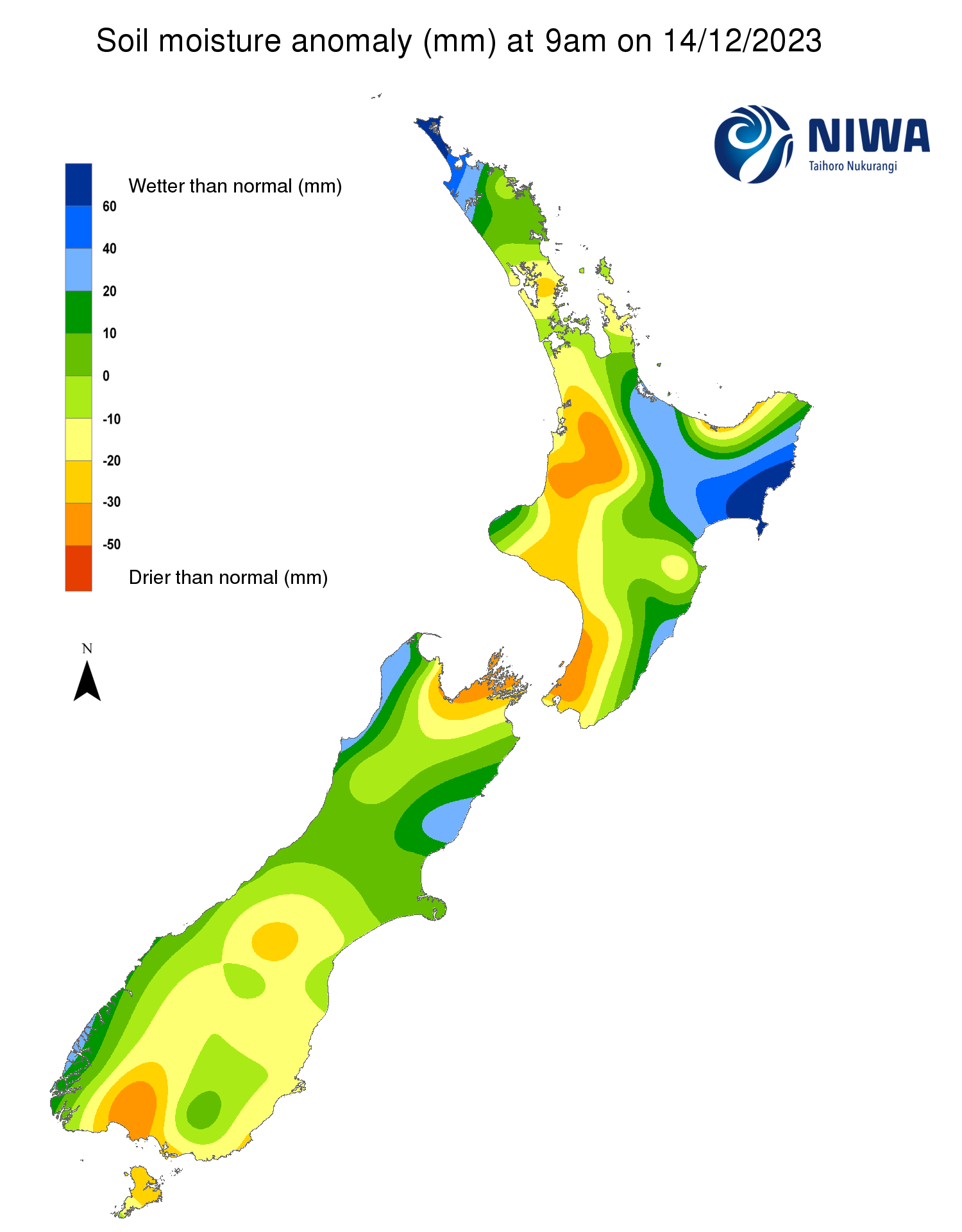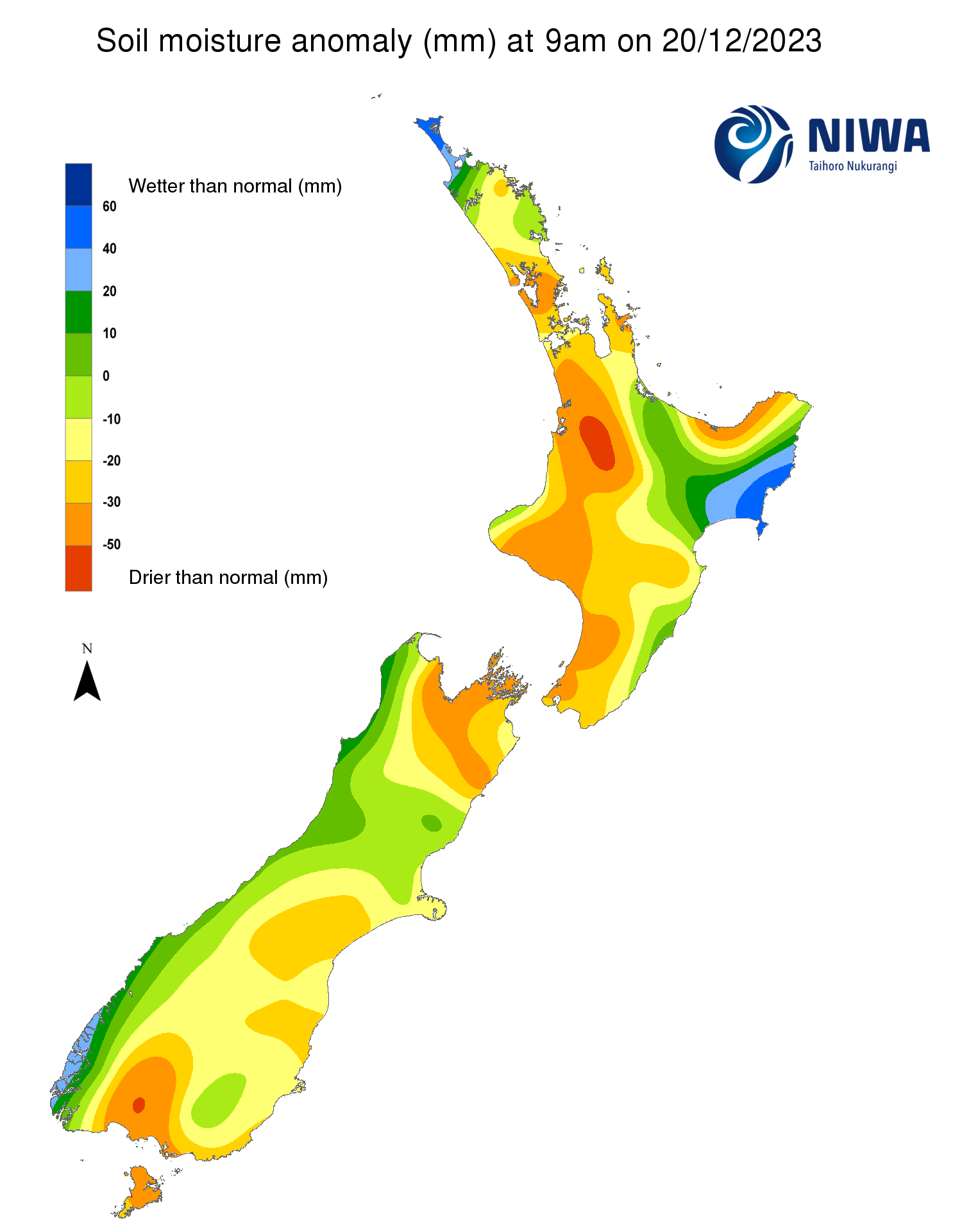A weekly update describing soil moisture patterns across the country to show where dry to extremely dry conditions are occurring or imminent. Regions experiencing significant soil moisture deficits are deemed “hotspots”. Persistent hotspot regions have the potential to develop into drought.
Recent rainfall and current soil moisture conditions:
North Island:
- Meagre rainfall totals of 5 mm or less were observed in much of the North Island in the past week.
- Pockets of rainfall totals of 10-25 mm were observed in western Waikato and Kapiti Coast, with some larger amounts in higher terrain.
- This resulted in significant soil moisture decreases across a majority of the North Island.
- The driest soils across the North Island, when compared to normal for this time of the year, are found in interior Waikato, while the wettest soils for this time of the year are found in Cape Reinga and parts of Gisborne and northern Hawke’s Bay.
- The previous hotspot in coastal Manawatū-Whanganui and the Kapiti Coast remains in place, while new hotspots have formed in northern Auckland, a small portion of interior Waikato, and coastal eastern Bay of Plenty.
- As of 18 December, the New Zealand Drought Index (NZDI) map below shows that abnormally dry conditions are currently found in parts of Wellington.
South Island:
- Rainfall amounts of 30-100 mm were generally observed in the West Coast in the past week.
- However, elsewhere in the South Island rainfall amounts were minimal—generally less than 10 mm.
- This resulted in significant soil moisture decreases in nearly all of the South Island except for the West Coast, where changes were minimal.
- The driest soils across the South Island, when compared to normal for this time of the year, are found in parts of Marlborough, Nelson, eastern Tasman and western Southland, while the wettest soils for this time of the year are found along the immediate western coast.
- South Island hotspots are now located in Greater Nelson, Marlborough Sounds, far northern Canterbury, parts of coastal South Canterbury, and western Southland.
- As of 18 December, the New Zealand Drought Index (NZDI) map below shows that abnormally dry conditions are currently found in parts of Tasman, Nelson, Marlborough, North Canterbury, Banks Peninsula, South Canterbury, Otago, coastal Southland, and Stewart Island. Very dry conditions are now located in parts of these same regions as well.


Pictured above: Soil Moisture Anomaly Maps, relative to this time of year. The maps show soil moisture anomalies over the past two weeks.
As of 18 December, the New Zealand Drought Index (NZDI) map below shows that abnormally dry conditions are currently found in parts of Wellington, Tasman, Nelson, Marlborough, North Canterbury, Banks Peninsula, South Canterbury, Otago, coastal Southland, and Stewart Island. Very dry conditions are now located in parts of these same South Island regions as well. Please note: some hotspots in the text above may not correspond with the NZDI map. This difference exists because the NZDI uses additional dryness indices, including one which integrates the rainfall deficit over the past 60 days. Changes are therefore slower to appear in the NZDI compared to soil moisture anomaly maps that are instantaneously updated.
![New Zealand Drought Index (NZDI) - 18 December 2023 [NIWA].](/sites/default/files/styles/wide/public/2023-12/NZDI_0.png?itok=p4bQnufy)
The week ahead:
North Island:
- Thursday through Saturday morning (21-23 December) will be mostly dry, but the chance for showers and periods of rain will increase on Sunday.
- Christmas Day and Boxing Day could be unsettled, with periods of at least moderate rainfall across the North Island.
- Weekly rainfall totals could reach 30-50 mm across much of the North Island, with pockets of higher amounts likely to occur. Rainfall totals could be slightly lower along the east coast.
- Due to the expected rainfall in the next week, small to moderate soil moisture increases are likely in much of the North Island.
- The current hotspots in the North Island may weaken at least somewhat in the next week, although they may not dissipate entirely. There is a small chance that a new hotspot could form in southern Hawke’s Bay.
South Island:
- A few showers will be possible each day through Saturday (21-23 December), although rainfall amounts will generally be light.
- Moderate to heavy rain may affect the West Coast on Sunday (24 December), with showers farther east.
- A few showers will again be possible during early-to-mid next week.
- Weekly rainfall totals of 50-100 mm are possible in the West Coast, with 20-40 mm in the lower South Island. However, amounts less than 20 mm are likely along the east coast.
- Due to the expected rainfall in the next week, additional soil moisture decreases will be possible in Marlborough and Canterbury, with slight increases possible in Otago and Southland.
- The current hotspots in the upper South Island and Southland may weaken somewhat in the next week, while the hotspots in Canterbury could strengthen.
Long-term outlook (through mid-January):
- The drier (25th percentile) and middle (50th percentile) rainfall scenarios both favour drier or much drier than normal conditions in the upper and eastern North Island and lower South Island through late January.
- However, in the wetter (75th percentile) scenario, above normal rainfall could occur in large parts of the North Island and upper South Island.
- Very dry soil conditions could affect parts of both islands in the drier rainfall scenario.
![NZ rain anomaly for 35 days from 18 December 2023 [NIWA].](/sites/default/files/styles/wide/public/2023-12/niwa35_Rain_0.png?itok=6Jv9gM1a)
![Risk of areas experiencing dryness or drought within 35 days from 18 December 2023 [NIWA].](/sites/default/files/styles/wide/public/2023-12/niwa35_NZDI_0.png?itok=8y3UedV1)
Pictured above: 35-day forecast rainfall anomaly scenarios (Top), and 35-day forecast dryness and drought scenarios (Bottom). These maps are updated daily at https://niwa.co.nz/climate/seasonal-climate-outlook
Background:
Hotspot Watch: a weekly advisory service for New Zealand media. It provides soil moisture and precipitation measurements around the country to help assess whether extremely dry conditions are imminent.
Soil moisture deficit: the amount of water needed to bring the soil moisture content back to field capacity, which is the maximum amount of water the soil can hold.
Soil moisture anomaly: the difference between the historical normal soil moisture deficit (or surplus) for a given time of year and actual soil moisture deficits.
Definitions: “Extremely” and “severely” dry soils are based on a combination of the current soil moisture status and the difference from normal soil moisture (see soil moisture maps at https://www.niwa.co.nz/climate/nz-drought-monitor/droughtindicatormaps)
Hotspot: A hotspot is declared if soils are "severely drier than normal" which occurs when Soil Moisture Deficit (SMD) is less than -110 mm AND the Soil Moisture Anomaly is less than -20 mm.

